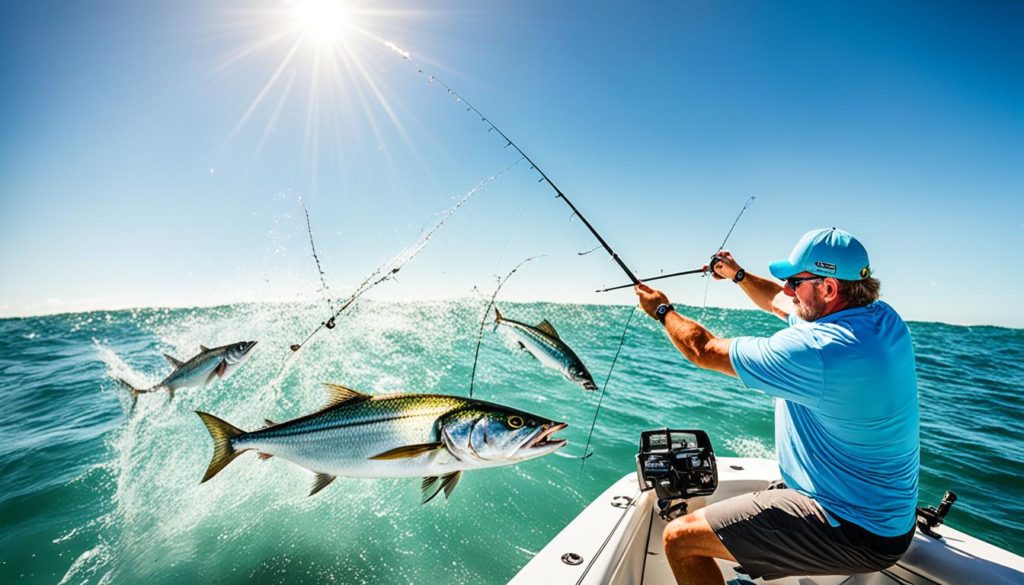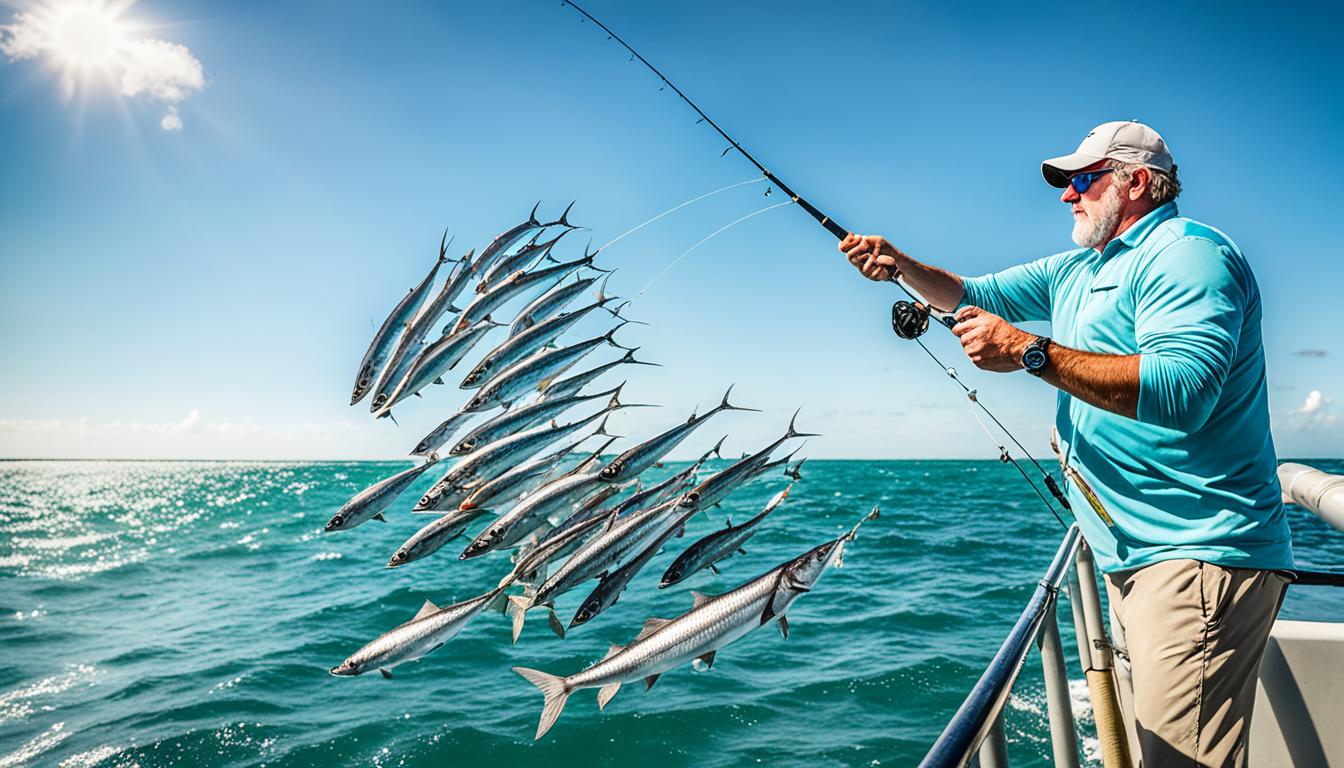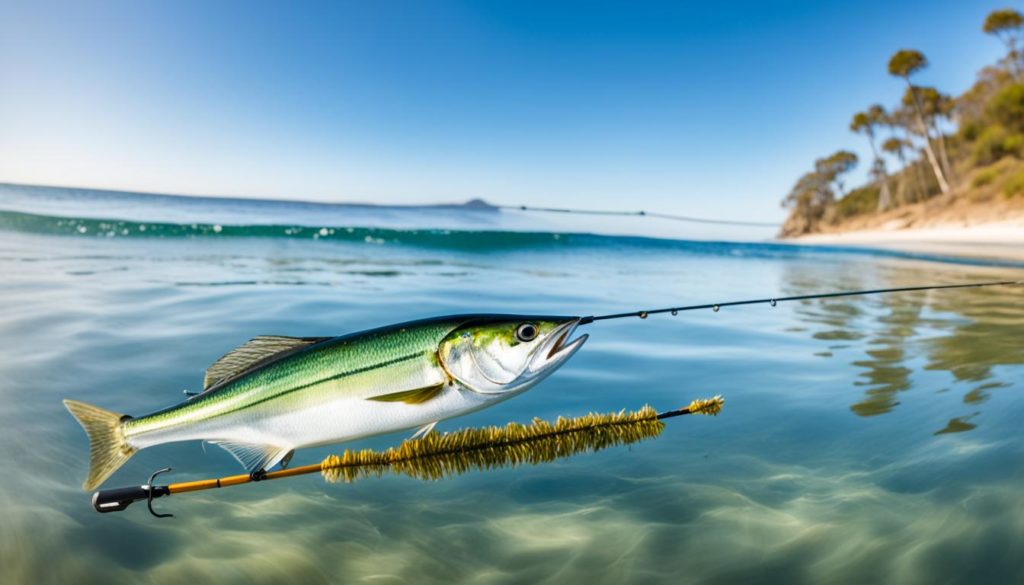Are you ready to embark on an exciting fishing adventure in the beautiful waters of Florida? Look no further than the Spanish mackerel! These feisty and delicious fish offer a thrilling experience for anglers of all skill levels. In this comprehensive guide, we will provide you with valuable tips and techniques to help you catch Spanish mackerel like a pro.
Key Takeaways:
- Equip yourself with the right tackle and gear for Spanish mackerel fishing.
- Rig up effectively to prevent the mackerel’s sharp teeth from cutting your line.
- Discover the top spots where Spanish mackerel can be found in Florida.
- Learn the most successful techniques for casting, trolling, and fishing in the surf or on the flats.
- Explore the best lures to entice Spanish mackerel and increase your chances of success.
Best Spanish Mackerel Fishing Tackle
When it comes to Spanish mackerel fishing in Florida, using the right tackle is essential for a successful and enjoyable experience. Whether you prefer casting or trolling, having the appropriate gear can significantly improve your chances of landing these fast and powerful fish.
For Casting:
For casting, a 7′ medium-light spinning rod with a fast action is recommended. This type of rod provides the right balance of sensitivity and power needed to effectively cast lures and light live baits. Pair it with a 2500 series reel that has a smooth drag system for seamless line retrieval and control.
For Trolling:
If you prefer trolling, a light conventional outfit is your best bet. This type of setup can handle the strain of dragging a planer or lure while allowing you to maintain control over your line. Opt for a medium-action trolling rod paired with a reel capable of holding a sufficient amount of monofilament line.
Choosing the Right Line:
When it comes to line selection, monofilament is the go-to choice for Spanish mackerel fishing. A 10 lb test line offers optimal performance, providing enough strength to handle the fish’s aggressive runs while still allowing for a natural presentation.
| For Casting | For Trolling | Line |
|---|---|---|
| 7′ medium-light spinning rod with a fast action | Light conventional outfit | 10 lb monofilament line |
| 2500 series spinning reel | – | – |
Rigging up for Spanish Mackerel Fishing
When it comes to Spanish mackerel fishing in Florida, one crucial aspect that anglers need to consider is the rigging. These sleek and speedy fish have razor-sharp teeth, making it essential to choose the right bait and tackle to ensure a successful catch. Here are some key rigging tips for targeting Spanish mackerel:
Bait and Tackle Selection
To get started, it’s important to choose the right bait and tackle for Spanish mackerel fishing in Florida. While wire leaders can be used, many anglers prefer using a clear 40 lb fluorocarbon leader, especially in clear water conditions. This type of leader is less visible underwater, greatly increasing the chances of enticing a bite from these wary fish.
When it comes to lures, opting for longer options is recommended when targeting Spanish mackerel. These fish often strike the back half of the lure, so choosing longer lures increases the chances of hooking them effectively.
Leader Attachment
Attaching the leader to the main line is a crucial step in rigging up for Spanish mackerel fishing. One popular knot for this purpose is the double uni-knot. This knot creates a strong connection between the leader and the main line while allowing for fluid movement of the lure or bait.
Rigging Diagram:
| Step | Rigging Process |
|---|---|
| 1 | Tie a double uni-knot to connect the main line to the fluorocarbon leader. |
| 2 | Attach the lure or bait to the other end of the fluorocarbon leader using the appropriate knot or clip. |
| 3 | Ensure the connection between the main line and leader is secure and the lure or bait is properly attached. |
Rigging up correctly for Spanish mackerel fishing increases your chances of hooking these fast and feisty fish. By selecting the right bait and tackle and using appropriate knots and connections, you’ll be well-prepared to catch Spanish mackerel during your fishing adventures in Florida.
Where to Catch Spanish Mackerel in Florida
When it comes to targeting Spanish mackerel in Florida, there are several hotspots where you’re likely to have success. These popular fishing locations offer a variety of opportunities to hook into these hard-fighting fish and make for an unforgettable fishing experience.
Inlets and Passes
Inlets and passes are prime locations for Spanish mackerel fishing. The strong tidal currents create a perfect feeding ground for mackerel as they ambush baitfish being swept through the channel. Look for areas with structure such as jetties or bridge pilings, as they tend to attract baitfish and concentrate mackerel.
Large Open Flats
Spanish mackerel can be found patrolling large open flats, especially in the southern regions of Florida. Look for flats with grass or vegetation, which provide cover and attract baitfish. These flats act as a buffet for mackerel, and targeting them in these areas can result in some exciting catches.
Inshore Waters of the Gulf and Atlantic Ocean
The inshore waters of the Gulf of Mexico and the Atlantic Ocean are home to thriving populations of Spanish mackerel. These areas offer a wide range of habitats, including grass flats, mangrove shorelines, and channel edges, which provide ample opportunities to find feeding mackerel. Keep an eye out for diving birds or surface activity, as they often indicate the presence of baitfish and mackerel below.
Artificial Reefs, Hard Bottom Areas, and Wrecks
When searching for Spanish mackerel, don’t overlook artificial reefs, hard bottom areas, and wrecks. These structures provide shelter for baitfish and create an ideal hunting ground for mackerel. Set up near these locations and present your baits or lures to entice the mackerel lurking below.
Remember, Spanish mackerel are highly opportunistic predators and are usually found close to schools of baitfish. By focusing your efforts in these hotspots, you increase your chances of hooking into some exciting Spanish mackerel action.
| Hotspot | Features |
|---|---|
| Inlets and Passes | Tidal currents, structure (jetties, bridge pilings) |
| Large Open Flats | Grass or vegetation, baitfish feeding grounds |
| Inshore Waters of the Gulf and Atlantic Ocean | Various habitats (grass flats, mangroves, channel edges), diving birds |
| Artificial Reefs, Hard Bottom Areas, and Wrecks | Shelter for baitfish, hunting grounds for mackerel |
Spanish Mackerel Fishing Techniques
When it comes to catching Spanish mackerel, there are two main techniques that anglers swear by. Whether you prefer casting or trolling, these fishing tips will help improve your chances of landing a prized mackerel.
Casting
Casting lures and baits is a popular method when targeting Spanish mackerel, especially when they are seen feeding on the surface. By casting your line near active feeding areas, you can entice mackerel to strike your bait. Anglers have also found success by drifting and casting live or cut bait, allowing the scent to attract mackerel.
Trolling
Trolling is another effective technique for targeting Spanish mackerel. By using spoons or shallow diving plugs, you can imitate the baitfish that mackerel feed on. When trolling, a speed of 5-7 knots has proven to be the most effective. This speed allows your lures to mimic the movement of natural baitfish, increasing your chances of attracting mackerel.
To enhance your understanding of these techniques, check out the following table that summarizes the main points:
| Technique | Tips |
|---|---|
| Casting | – Target surface feeding areas – Use lures and live/cut bait – Drift and cast to cover a wider area |
| Trolling | – Use spoons or shallow diving plugs – Maintain a speed of 5-7 knots – Mimic the movement of baitfish |
Remember, the right technique will depend on the prevailing conditions and the behavior of the mackerel. Experiment with different approaches to find what works best for you. Now, let’s move on to the top Spanish mackerel fishing lures in the next section.
Top Spanish Mackerel Fishing Lures
When it comes to Spanish mackerel fishing in Florida, having the right lures can significantly increase your chances of success. Here are three popular lures that are known to attract these feisty game fish:
- Rapala X-Rap plug: This long and slender plug is designed with erratic action that drives Spanish mackerel crazy. The lifelike appearance and realistic swimming motion make it a go-to lure for anglers targeting these fish. (Image not available)
- Kastmaster spoon: One of the most versatile lures for Spanish mackerel, the Kastmaster spoon can be cast long distances and imitates a wounded baitfish. Its flashy design and irresistible action make it a favorite among anglers. (Image not available)
- Jig and grub combo: This combination offers versatility and the ability to imitate local forage. Jigs with soft plastic grub trailers can be worked at various depths and provide a lifelike presentation that Spanish mackerel find hard to resist. (Image not available)
By using these lures, you can mimic the baitfish that Spanish mackerel feed on, increasing your chances of enticing a strike. Experiment with different colors and retrieve speeds to find what works best for the conditions you’re fishing in. Remember to match the size of the lure to the size of the baitfish the mackerel are targeting.
Stay prepared with these effective lures and get ready for an exciting Spanish mackerel fishing adventure in the beautiful waters of Florida!
See the table below for a summary of the top Spanish mackerel fishing lures:
| Lure | Description |
|---|---|
| Rapala X-Rap plug | A long and slender plug with erratic action that triggers strikes. |
| Kastmaster spoon | A versatile lure that can be cast long distances and imitates a wounded baitfish. |
| Jig and grub combo | A versatile combination that imitates local forage and can be jigged at various depths. |
Trolling for Spanish Mackerel
Trolling is an effective technique for targeting Spanish mackerel in the waters of Florida. By moving at a speed of 5-7 knots, anglers can cover a lot of water and increase their chances of finding fish. This method allows you to present your lures at different depths and attract the attention of mackerel at various levels in the water column. To achieve this, you can use inline sinkers or planers to get your lures down to the desired depth.
When trolling for Spanish mackerel, it’s important to target areas where these fish are likely to be found. Reefs, wrecks, and bait schools are known hotspots for mackerel. These fish often congregate around these structures, feasting on the abundant baitfish that seek refuge there. By focusing your trolling efforts around these areas, you can significantly increase your chances of hooking into some hard-fighting mackerel.
For a visually engaging and informative presentation, refer to the table below for a summary of key points when trolling for Spanish mackerel:
| Key Points for Trolling for Spanish Mackerel |
|---|
| Use a trolling speed of 5-7 knots to cover a larger area and attract mackerel. |
| Utilize inline sinkers or planers to get your lures to the desired depth. |
| Target reefs, wrecks, and bait schools for the best chances of success. |
So, when you’re out on the water in Florida targeting Spanish mackerel, consider giving trolling a try. It’s a versatile and effective method for covering more ground and increasing your chances of encountering these exciting saltwater game fish.
How to Catch Spanish Mackerel in the Surf
During the spring and summer months, Spanish mackerel can be caught off the beach. To maximize your chances of success, it’s important to know where to look and what techniques to use. Here are some valuable tips for catching Spanish mackerel in the surf:
1. Look for Diving Birds
When searching for Spanish mackerel, keep an eye out for diving birds, such as least terns. These birds indicate the presence of baitfish that mackerel like to feed on. Spotting diving birds can help you narrow down your fishing location and increase your chances of finding a mackerel hot spot.
2. Use Smaller Lures
When targeting mackerel in the surf, it’s important to use smaller lures that imitate the baitfish they commonly feed on. Spoons and jigs are effective choices for attracting mackerel’s attention and triggering strikes. Consider using lures with shiny finishes to mimic the flash of baitfish in the water.
| Lure Type | Best Application |
|---|---|
| Spoons | Spoons are versatile lures that can be cast a good distance and retrieved at varying speeds. They imitate wounded baitfish and attract mackerel with their flash and erratic action. |
| Jigs | Jigs tipped with soft plastic grubs or swimbaits can be deadly when targeting mackerel. Their lifelike action and appearance closely resemble the small fish that mackerel feed on. |
Remember to experiment with different colors and retrieve speeds to find what works best on the day!
Catching Spanish mackerel in the surf can be an exciting and rewarding experience. By following these tips and adapting to the conditions, you’ll increase your chances of hooking into these fast and powerful fish.
How to Catch Spanish Mackerel Trolling
Trolling is a productive method for targeting Spanish mackerel. By trolling a small silver spoon behind your boat, you can cover a lot of water and increase your chances of finding fish. This technique is especially useful for locating schools of baitfish that mackerel are feeding on.
When trolling for Spanish mackerel, it’s important to maintain a consistent speed and vary your trolling depths to effectively mimic the movement of the baitfish. Keep an eye on your depth finder and adjust your trolling speed accordingly to keep your lure at the desired depth.
Many anglers prefer using spoon lures for trolling Spanish mackerel. The shiny, flashing action of a spoon mimics the movement of a wounded baitfish, making it irresistible to hungry mackerel. Choose a small silver spoon in the 2 to 3-inch range for optimal results.
It’s important to pay attention to your rod and reel setup when trolling for Spanish mackerel. Use a medium-heavy spinning rod paired with a reel capable of holding at least 150 yards of fishing line. For trolling, it’s recommended to use monofilament or braided fishing line with a test strength of around 20 lb.
When trolling, it’s also advisable to use a wire or fluorocarbon leader to prevent the mackerel’s sharp teeth from cutting through your line. A 30 lb wire leader or a 40 lb fluorocarbon leader should do the trick. Remember to use a snap swivel to easily change lures and avoid line twists.
As with any fishing technique, it’s important to be patient and experiment with different trolling speeds, lure colors, and depths until you find what works best. Remember, Spanish mackerel are known for their fast and powerful strikes, so be prepared for an exciting fight once you hook into one.
Top Tips for Trolling Spanish Mackerel:
- Choose a small silver spoon lure in the 2 to 3-inch range.
- Maintain a consistent trolling speed of around 5 to 7 knots.
- Vary your trolling depths to mimic the movement of the baitfish.
- Use a wire or fluorocarbon leader to prevent the mackerel’s sharp teeth from cutting through your line.
- Pay attention to your rod setup and use a medium-heavy spinning rod paired with a reel capable of holding at least 150 yards of fishing line.
“Trolling can be a highly effective technique for targeting Spanish mackerel. By covering a large area of water and mimicking the movement of baitfish, you’ll increase your chances of hooking into these fast and powerful fish.” – Capt Jim, Siesta Key charter boat captain
How to Catch Spanish Mackerel on the Flats
When targeting Spanish mackerel in Florida waters, exploring the flats can offer an exciting opportunity. Spanish mackerel can often be found on the deeper parts of flats or in deeper channels, where they hunt in open water, searching for their prey. They have a unique feeding behavior, herding baitfish into a bait ball near the surface.
If you’re already fishing for other species on the flats, don’t be surprised if you encounter Spanish mackerel as a bycatch. They are fast and aggressive, providing an additional thrill to your angling experience.

Conclusion
Spanish mackerel fishing in Florida offers an exhilarating experience for anglers seeking action-packed adventures. By utilizing the right tackle, employing effective techniques, and selecting the appropriate lures, you can significantly increase your chances of a successful fishing trip. Whether you prefer casting, trolling, or targeting them in the surf or flats, Spanish mackerel provide thrilling fights and delicious meals, making them a popular target among Florida anglers.
With the detailed tips and insights shared in this Florida fishing guide for Spanish mackerel, you are well-equipped to embark on unforgettable fishing expeditions. Remember to choose a 7′ medium-light spinning rod with a fast action and a 2500 series reel for casting, or a light conventional outfit for trolling. Rigging up with a clear 40 lb fluorocarbon leader and using long lures that mimic baitfish can increase your chances of attracting these feisty predators.
Whether you’re exploring the inlets and passes, vast open flats, or inshore waters of the Gulf and Atlantic Ocean, keep an eye out for bait schools and diving birds to locate Spanish mackerel hotspots. Additionally, master the art of casting and trolling using spoons, shallow diving plugs, and jig and grub combos, which are among the top lures for Spanish mackerel fishing in Florida.
So, get ready to immerse yourself in the thrill of Florida fishing and unleash your fishing prowess as you venture out to catch Spanish mackerel. Enjoy the adrenaline rush and savor the flavorful rewards that await you in the bountiful waters of the Sunshine State.
FAQ
How do I catch Spanish mackerel in Florida?
Spanish mackerel can be caught by casting or trolling. For casting, use a 7′ medium light spinning rod with a fast action and a 2500 series reel. For trolling, a light conventional outfit is recommended. Use monofilament line with 10 lb test for optimal performance.
What should I use for rigging up for Spanish mackerel fishing?
When rigging up for Spanish mackerel, use clear 40 lb fluorocarbon leader in clear water conditions. Attach the leader using a double uni-knot. Use lures that are long, as mackerel usually hit the back half of the lure.
Where can I find Spanish mackerel in Florida?
Spanish mackerel can be found in inlets and passes, large open flats, and inshore waters of the Gulf and Atlantic Ocean. Look for them on flats with grass or vegetation in the South, and around artificial reefs, hard bottom areas, and wrecks in open waters.
What are the best techniques for Spanish mackerel fishing?
The two main techniques for Spanish mackerel fishing are casting and trolling. Casting lures and baits is popular, especially when mackerel are feeding on the surface. Drifting and casting live or cut bait is also effective. When trolling, use spoons or shallow diving plugs to imitate baitfish.
What are the top Spanish mackerel fishing lures?
Three popular lures for Spanish mackerel fishing are the Rapala X-Rap plug, Kastmaster spoon, and jig and grub combo. The Rapala X-Rap is a long slender plug with erratic action. The Kastmaster spoon imitates a wounded baitfish. Jig and grub combos imitate local forage.
How can I troll for Spanish mackerel?
Trolling spoons or shallow diving plugs at a speed of 5-7 knots is a productive method for catching Spanish mackerel. Use inline sinkers or planers to get the lures down to the desired depth. Reefs, wrecks, and bait schools are top spots for trolling.
How do I catch Spanish mackerel in the surf?
During the spring and summer months, look for Spanish mackerel off the beach where there are diving birds indicating the presence of baitfish. Use smaller lures like spoons and jigs for targeting mackerel in the surf.
What are some tips for catching Spanish mackerel trolling?
When trolling for Spanish mackerel, use a small silver spoon behind your boat to cover a lot of water and find fish. This technique is especially useful for locating schools of baitfish that mackerel are feeding on.
How do I catch Spanish mackerel on the flats?
Spanish mackerel can often be found on the deeper parts of flats or in deeper channels. Look for them herding baitfish into a bait ball near the surface. Anglers targeting other species on the flats can also encounter Spanish mackerel as a bycatch.
Is Spanish mackerel fishing popular in Florida?
Yes, Spanish mackerel fishing in Florida is popular due to the fish’s hard fights and delicious taste. By using the right techniques, tackle, and lures, anglers can increase their chances of success in catching Spanish mackerel.


